The Technique of the Present1
Jean-Luc Nancy
1.
Poetry, before being the name of a particular art, is the generic name of art. Techné poiétiké: productive technique. This technique, that is, this art, this calculated operation, this procedure, this artifice produces something not with a view to another thing or a use, but with a view to its very production, that is, its exposition. The pro-duction of the thing puts the thing forward, presents and exposes it.
To expose is to depart from a simple position, which is always also a deposition, a relinquishing of the contingence of a passing moment, a circumstance or a point of view. What is exposed is placed in the order of absolute, immutable and necessary presence. The word poiesis is derived from a word family that designates ordering, arrangement, or disposition. Poetry disposes. Art is disposition. It disposes the thing according to the order of presence. It is the productive technique of presence.
Presence is not a quality or a property of the thing. Presence is the act by which the thing is put forward: prae-est. It is put forward or in front of its nature as a thing, and of everything which immerses this nature in the world of its connections: origins, relations, process, finalities and becomings. The nature of the thing is in its birth, as the word "nature" indicates, and in its unfurling within these relations. It can subsist only in this movement, and its permanence is in the passing. But presence is the act that subtracts a thing as it passes. In this way it subtracts the thing from its thingness, or it withdraws the thingness from the thing – that is, all the reality of the res – in the single foregrounding, in this single advancement.
This advancement is that of the present. The present is not ahead in time, for that which is ahead in time in relation to a past, is immediately behind in relation to a future. Unless the contrary is true. But in either sense, the present in time is nothing: it is pure time, the pure present of time, and thus its pure presence, that is, the negativity of the passing. From "already no longer" to "not yet", is a passage without pause, a step not taken, neither disposed nor exposed, inexposable, only and ceaselessly deposing all things.
On Kawara's question is how this inexposable can be exposed. (In a certain sense, it is perhaps a question which the arts never cease to take up and pass between themselves: how to grasp the ungraspable of passing, how to grasp the pure conjunction of passing and presence, of fleeing and stasis?)
The present of presence is not in time, it is ahead of time, in front of time. Or it is within it, not in its course, but in its most intimate heart or hollow. It is pure time subtracted from temporality: the space in which pure time opens out and inexposes itself. Space does not represent time, like a line that would be the immobile figure of a mobile process, but space opens time, distends time, distending the very moment to expose this present that does not pass, and that is time itself, negativity imposed for itself. Space is thus the origin of time. It is simultaneously its point of nullity and the whole extension of its successivity. It is the opening of time, the simultaneity of its spacing.
On Kawara's art is a productive technique of this spacing, which, in effect, does not produce itself. It is not in nature. In nature, there is only the passage, the passing or the pass of time. Only outside nature can there be time itself. Outside nature: in a technique, in art.
The spacing of time, or space opening time as such and as a totality, is before time, outside of time – in this "outside" that is not another place, because it is outside all places, but which is the taking-place of place in general and of all places. A place is always the curving or collecting of a certain closure (with its thresholds and outlets) within absolute spacing – or rather: a curving of this very within. There is thus no place for the pure spacing presupposed by every place. In the same manner (and it's the same thing), there is no world in which the creation of the world takes place. Thus creation does not take (its) place. But what it is, or what it does, puts in place any possible place, and any taking-place.
How, despite everything, can creation itself or absolute spacing be put in place? How can time leave time? What ruse, what detour, what skill can be used?
On Kawara's art proposes a technique to put in place spacing itself, to put forward and expose spacing itself according to the curve, the contour, the frame of a place, in its local color.
For within time, the spacing of time does not present itself. Space-time itself does not open its creative hollow in time and space. A technique must be used for that: a technique, in sum, to recreate the creation that has not taken place.
There must be a technique, just as there must be a technique to measure passing time. Clocks and calendars put chronometric techniques to work. They measure the number of time. But here is a chronometry that measures time's spacing, its opening, preceding and spanning its gap. It is chronomorphic poiesy.
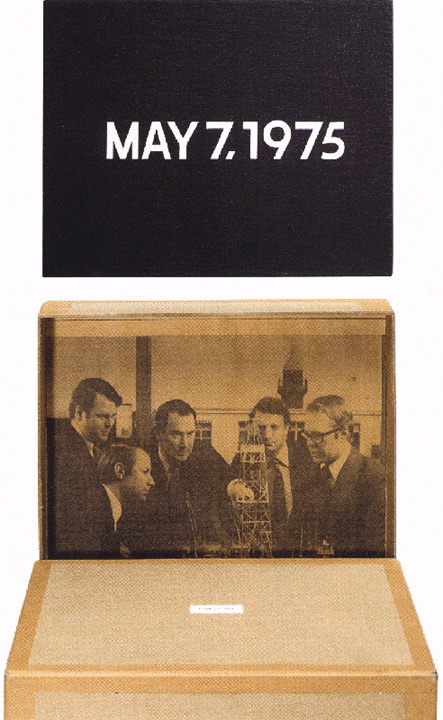
2.
On Kawara gathers the time of men, measurers of time. A million years back, a million years ahead. Between the two, the space where we are: we here now, as much as and as everyone, at every moment and in every place. But everyone, also, in the present of he who makes the work, and who withdraws from it as he opens it, who withdraws from it as he exposes it.
Two million years do not constitute a history: they are history itself – along with prehistory and posthistory – in the totality of its span and sway. Not history as a grandiose or confused movement of the destiny of peoples, nor as the monumental heaping together of culture and barbarity, nor as an adventure of events, but history as the simultaneous presence of its millions of histories, present history, presentified history.
In Greek, the meaning of historia is a collection or recollection of occurrences. On Kawara exposes the recollection of humanity past and humanity yet to come, subtracted from memory and expectation. The collection of a considerable number of years is in itself merely the logarithmic index of the monstrous or prodigous number of those that have passed and those that will pass. The "million" is not a count, it is the numeral or the code of the incommensurable, in the shape of a common measurement. All are present together, already past not yet arrived, unnamed, not anonymous, bound in a unique, complex collection: not "men" but representatives of the present.
Those who open space-time each time, those who from within nature distance nature, the technicians of presence: makers of steles, stanzas and instants. They are there grasped in their formidable absence, indistinguishable and unfigurable, artists, artisans, artificers.
There is nothing to read in this long collection, nothing of their histories, nothing but the exhausting numerals of a computation that refers to no founding or revolutionary event, to no feast or celebration. (Of course, the western Christian calendar is used, but its only function is as a universal indicating technique: in itself, it is merely the technical dissolution of its occidental specificity, and B.C. or A.D. no longer have sense, but are merely formal codes of location.) The only solemnity is the very idea of the solemn: that which takes place once a year, and here, it is the year itself insofar as it returns, identical and different, the solemn return of the annual.
The year presents the annular space of a cycle of life and death. Beyond this, there is no cycle, there is history with its great rhythmic irregularities; but still further beyond, there is the simultaneous eternal present. Nothing distinguishes one year from another but the difference of a numeral, and nothing presents the perennial but the simultaneity, here, of all these differences. Their self-same sameness.
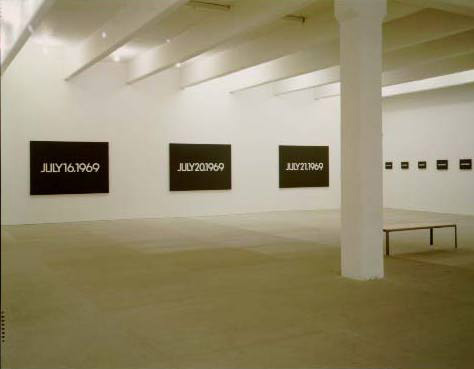
What can thus be read in this collection – and what is read aloud, pronounced by the alternating voices of a man and a woman, recorded and broadcast in this very hall – are the numerals that form the numbers of the years. The numbers have no signification. They constitute an order. They force a reading of the ordering of difference in identity, like that of the identity of their enunciation in the sexed difference of the voices. The reading of the collection – this reading that is more or less impossible and nonetheless available – is strictly ordered by its writing, by the reproduction of the traces of numerals one after the other, one by one and side by side, in the minuscule time of the mechanical strokes. Poetry without letters or words, poetry of cadenced regularity, numeral after numeral, going to the next line as the number changes, to the versus of the line, verse after verse, caesura after caesura, calculated discretion.
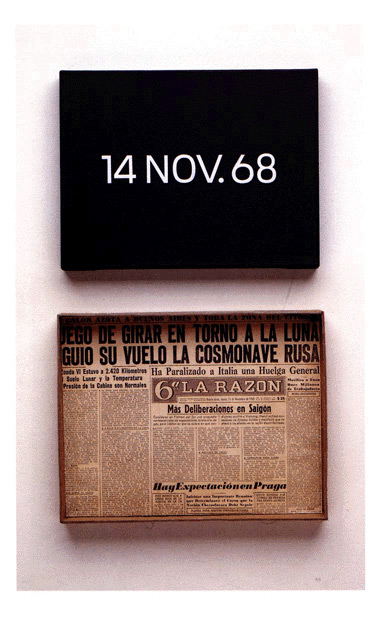
3.
July 21, 1969: the date of the first moon landing of human cosmonauts. It's the date on which those who mark time, its artists, concretely open up the cosmic spacing of time. There is no longer a sublunar world of time, and a supralunar world of pure presence. The moon is no longer a signal of the partitioning of spheres, but is itself merely one of the points from which the space of time opens out simultaneously in all directions in the universe, one of the innumerable points stochastically disposed everywhere where there is someplace.
There is no art that is not cosmological, because the productive technique of spacing produces the world each time, an ordering of the world, the world in whole or in part, but always the whole in each part each time. The world is never anything but the indefinite reference of all its points between themselves, and what is called a work of art is each time a singular, monadic and nomadic solidification of the cosmos.
On July 21, 1969, something happens in the history of painting, and of poeisy in general. The heavens are no longer celestial. They are neither the province of light above all figures, nor the region of transfigurations. They are no longer heavens but space, and the night of space whose sole figure is the date: the arbitrary notation of its obscure opening. They are neither ground nor form, but the universal spacing of spaces, from all points to all other points: the ensemble of openings to the ensemble of what is open.
Thus, the painting entitled July 21, 1969 paints the heavens because it covers one space among many with paint, a space identical to all spaces, and which is, as much as any other, at this instant, here and now, the origin or center of all spacing. It is not man's conquest of space, but space's request of man.
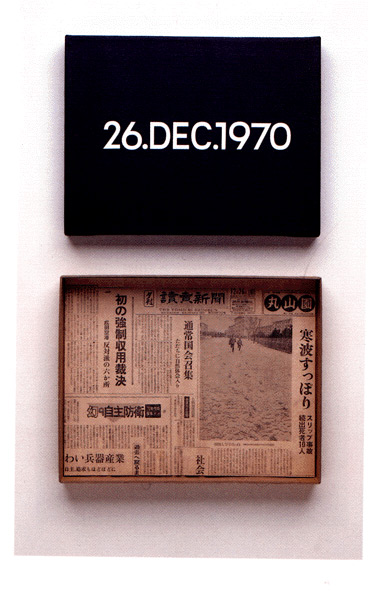
4.
It is therefore the sacred, sacred painting, which is in question. That is to say, not painting used to represent religious themes, but the sacred proper to painting itself – and, in general, to the re-productive technique of the world. The sacred operates by setting aside or setting apart, insofar as this distancing is the condition of the relation or of communication – or more precisely, insofar as this gap is the condition of the infinitude of the relation. (The sacred is nothing other than the ordinary condition of communication: reserve, threshold, access without access.)
Painting cuts out a space – the most basic sacred gesture, the trace of the templum. The templum is the cut-out of the heavens, the caeli lucida templa that Lucretius speaks of and also calls magnas caeli cavernas.2 The templum is a hollowing-out of the heavens which defines relations, and, consequently, non-relations as well.
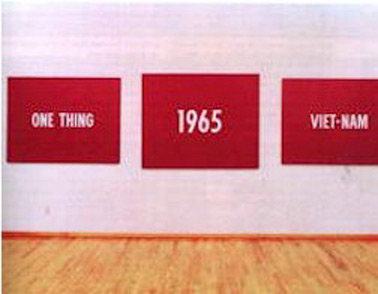
The triptych is a classical form, or format, of western ecclesiastical painting. It is often placed above or before an altar. It can often (and originally, it always could) fold onto itself. It forms an articulation of spacing, a space that can open or close onto that which can be considered both as part of itself and as another space. It exposes the fold and the unfolding of space.
Viet-Nam persists as the proper name of a time when the world had to learn of another kind of partitioning than that practiced by imperial domination. The principle of an empire is beyond space and time. It is a punctual and immobile power which extends indeterminately, and virtually interminably. Empire crushes the distances it extends. It is a spreading out, not a spacing.
The dismembering of empire is a dis-location which distinguishes places. Here, Viet-Nam, opens the present, 1965, of a partitioning of spaces which put a relation in place. It is a matter of understanding how each thing – one-thing, the "one" and the "thing" intrinsically linked – has its own place, puts its place in place, and puts equal places in equal relations.
A place is opened and delimited by the always similar taking-place of an event that is always different. Taking-place is merely the intersection of time and space – its opening. This opening is singular, producing each time its own local color – or rather, the place itself as a color: it is the topology of geographical maps. This color, here, the color of the triptych Viet-Nam, is called "magenta" or "red magenta". This is the name of a battle in which the troops of an empire were vanquished, in 1859. In 1860, the dark crimson coloring was discovered and given the name of the deadly battle of the preceding year. This color is the datum of a bloody spatter.
Painting does not use colors, it produces the color of a place insofar as this place is an origin of the world. On the one hand, the place is independent of all places, and each locality is absolute: it instantly colors the totality of a world. But on the other hand, the place is merely localized by its relation to and distance from all places. It is ordered by its coordinates to the very ends of the world.
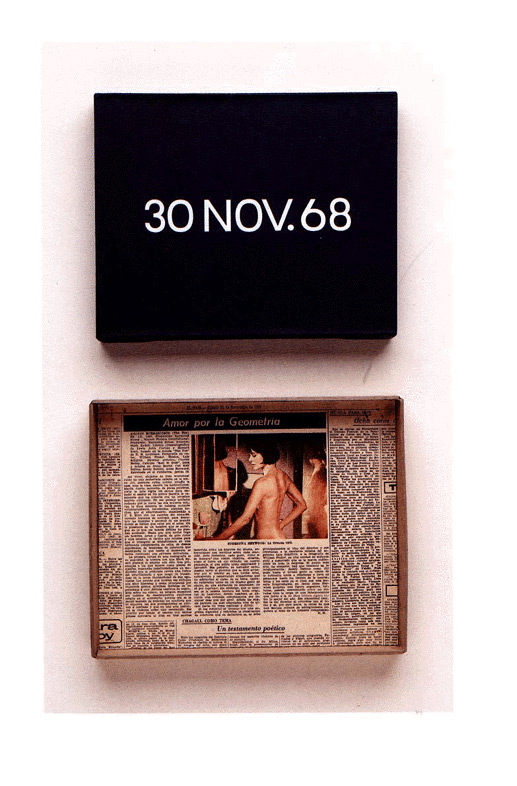
The painting entitled Location paints the place of locality in general, painting it by the coordinates of a singular place. Latitude is a given measured in relation to the equator, which is the greatest length of land along the axis which does not connect the poles. Longitude is a given measured in relation to an arbitrarily selected meridian (at least, according to the arbitrary choice of making localization occidental and, in the Occident, English: the imperial place of geography). "Meridian" means "partitioning of the day": it is the line along which time (the hour) is the same from one of the Earth's poles to the other. Place is the intersection of the two measurements, according to space and according to time, the point where the one and the other prove to have no dimension, merely the crossing of two lines.
Nothing subsists in a point, except for the simple exteriority of points in relation to each other. A point consists of nothing (it has no "inside"): it is merely relation to other points. There is no point of space nor point of time (as if it were a little particle of the one or the other), but space and time are the one-outside-the-other of punctuality itself. Thus puctiform space immediately opens time which goes from one point to the other – and time opens space as the truth of its trajectory (the point which is already not the one and not yet the other). The encounter of space and time: here-and-now.
This is not in the least abstract: it is the concrete itself – and it is what is present here. For this painting does not represent the coordinates of a point (which can, moreover, be found on a map and situated in the desert of North Africa). It does not represent: it gives the coordinates. It presents the truth of the point: its non-existence outside of its relation to all the points of this painting itself, its concrete absolute. The point pointed to here is in a determinate relation, always calculable, with the precise place where the painting is hung or placed. It is the concrete itself abstracted, that is, withdrawn from all that is not itself in its very concreteness. Hard as a grain of desert sand.
(A brief word on "conceptual art": On Kawara has often been presented as a conceptual artist. He himself strictly refuses this classification. Indeed, it has no more justification than most of these sort of qualifications, "abstract art" or "minimal art", etc. If art can be conceptual, it is in the sense that "conceive" signifies gathering and containing in the self, giving place, space and form to a presence. But in this case art is always conceptual – and, most importantly, the concept must always end by conceiving of itself as art.)

5.
This painting which foregrounds the spacing of time as such foregrounds – exposes – that which, precisely, is not as such. It is not possible to say what the spacing of time is as such, because it is negativity for itself.3 Negativity cannot pose itself as itself (which would also suppose that it can be taken as something else, as another kind of thing): it can only open, it opens, it hollows out or punctures, it has no genre, not even its own. Unexposable, absolute exposer.
The spacing of time is not a being, nor an operation of being or in being. If there is something in it, whatever it might be, it takes place only on the condition of the spacing of time, which is therefore anterior or exterior to being. Or more precisely: the spacing of time is the act of being – but not in the sense of the action of a subject. It is an act coextensive and cooriginary to being itself. It is thus so little "something" that not only is it not in space nor in time, but it is neither space nor time, and it is, insofar as it is, closer to this: space and time are two names, a double name, rather – space-time – for the necessarily double nature of that which is essentially outside itself (that whose essence consists in the outside-itself).
Space-time is the unity of that which is outside itself in its very unity (or rather: outside it). It is the opening of the world, of creation – but creation without a creator, without which space and time would only be in God, and thus, being in him, led back to a subsisting unity with neither space nor time. The one and the other, or rather, this one-other which they form together, are the originary extroversion of that which does not subsist in itself. Space is the condition of temporal passage, and time is the condition of spatial passage: the universal outside of the network of referrals which makes the inside of the world.
The present is the negation of the double passage, or the pure grasping of the passage as such, immobilized on itself in its very movement: the instantaneous point and the punctual instant. The pure present is that which is purely outside the world, like its creation. But outside the world, there is no outside of the world: neither space, nor time of creation. Outside the world there is the outside of the outside: the intimacy of the opening.
Poetic technique is devoted to presenting this present, what we call "re-presenting" not in the sense of recopying, because there is nothing here that can be copied, but in the sense of putting in front, putting forward. This art is devoted, like all art, perhaps, from its own angle, to putting forward that which remains buried, putting into the world that which is outside-the-world.
With On Kawara, this technique is devoted to this project under a condition which may at first seem purely tautological. The date says nothing but itself. It could happen, moreover, that the tautology is multiplied in the redundancy of several canvases painted on the same day, bearing the same date. In saying nothing but itself, the date says nothing of itself: this time it is the date of nothing, of no event. It says of itself only (and it doesn't say it, it isn't visible): that it is painted the very day. In French, one can say, with all the resources of ambiguity: it is painted of the very day/ on the very day.
Moreover, it is in this and only this way that the date can speak in painting, that it is, effectively, and there again in all its ambiguity, the subject of the painting: it does not discourse on a story, it only announces itself, utters itself, offers itself. Nothing but a point in the network of all the dates of the world – of all the dates that the world is, being nothing else and itself dateless. That's why the date is not read on the canvas: it is not interpreted, it does not enter into a story, but one can only hear it. One hears a voice, although this time there is no recording to accompany the plastic and graphic work. One hears a voice, that is, a timbre and a tone, not a word. One hears time [le temps], one hears the which of the date [le tant],4 as is said in French to indicate an undetermined date, the date in general or the idea of the date: "le tant", "on est le tant" [what date is it?]), the tantum quantum, the quantity of measured time, not according to its duration, but according to its occurrence. Furthermore, what one hears in this way, before the canvas and coming from the canvas is not a foreign voice given the task of reporting the date, giving the information about it. One hears oneself saying the date: I see the canvas and I pronounce its date, thus repeating that which makes the canvas itself. With a canvas voice, matte and flat against the wall, each person says the which of the date [le tant] again.
Reference to events is not absent, if one refers to the canvas' protective box, also exposed sometimes, containing one page of a newspaper from the day and the place where the canvas was made. But the properly pictorial gesture consists precisely in separating the date from its use as a point of reference for events and information.
Tautological painting of the date makes the date what it is: a pure datum, with no other reference. "Date" comes from the formula littera data, "given letter," consigned on this day. The date is the being-given of the given, or the given as such.
As such, the given is only present: posed, deposed, being-there, without past and without future, without provenance and without destination, without donor and without recipient. The pure given as such in itself cancels the gift, reabsorbing the giving. Thus, strictly speaking, it is no longer given. The Date painting erases the date: it reinscribes it outside its giving, outside its dating. This date no longer dates: it is eternalized by the Date painting. For this reason it multiplies it indefinitely: the erasing is infinite because it is still on the date that the date erases itself. On the date of the painting - the day itself – but also the date of each reexposition of the painting.
Such is the logic of the present: at this precise moment, the moment erases itself, and this is how it is a moment. The voice becomes silent, sticks to the canvas, and this is how it resonates: and its resonance is painting. The instant is unstable, and in this way it is an instant. The present is a spacing in which presence conceals itself. That is to say that it does not subsist there. It is not given, posed, deposed, available as an object, as a thing. The present opposes presence: it ruins it, abducts it, in the same movement by which it brings it.
The most one can say is that presence gives itself: it gives itself and conceals itself, in the same gesture of the present, in the same comings and goings of the present. But giving itself is precisely not to be given. Giving itself is the act of a subject – and it may very well be the exemplary act of the subject. But this assumes that it takes itself from this side of itself in order to deliver itself beyond itself. In this gesture, the self subtracts itself. It is nothing – if it can be said to "be" – but the distance between this side of it and its beyond. This distance "is" thus the self "itself", the present of the self – not its presence: the space it needs to be itself, to attain the self as much as to return to the self.
The date is here the subject. That is to say that the subject of this painting is the subject, absolutely. What must then be understood here is that the subject, here, paints itself. Or rather, if one wishes, that painting, here, subjectivises itself. These two propositions are correlative and reciprocal. Painting and subject identify the one with the other, and the one by the other.
(It must be immediately specified that this may have something, or nothing, to do with the individual subject On Kawara, with his anxiety or with his certainty of being himself, and being a painter, and existing in general, etc. In this respect, all hypotheses are equally possible, and they are equally indifferent, at least in respect to what is presented to us, which is painting, and not an encounter with a person. There is no presence of no one: nothing but the present of painting.)
The subject can only be present as [en tant que] a painted subject. Painting can be present only as [en tant que] a painting of the subject. Painting is the presenter (or giver) of the subject just as much as the subject is the presenter (or giver) of painting. The present cannot be such as it is [en tant que tel] except in the spacing of the present, that is, of time itself. The subject can be only the subject of a retreat on this side, and not beyond, its own presence.
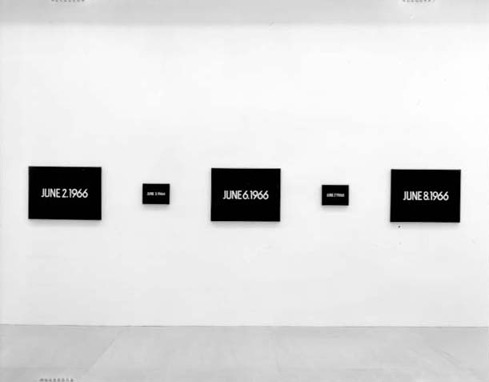
6.
From this group of interdependent propositions, the Date paintings allow for verification on four broad axes:
1) painting itself, that is, the pigment, paste, diligently applied, smoothed to the limits of the pure plane without, nonetheless, doing away with the traces of the brush, affirming that a ground is covered over, making the ground come forward - the pure thickness obscure in itself – like a ground that surfaces, the presentation of a ground, like the side of a cut-off corner where the ground opens the eye: it itself opens like an eye that looks at us by opening our eyes. What can be seen in this way is painting emptied by the present of its own execution. I paint the date on which I paint. As if each painting, here, was an enlargement of one of the corners where the painter has painted the date the painting was completed. But also: as if the date were a naked ground which had to be painted. Painting, in this sense, is first of all the affirmation of a surface. Why paint the walls of a room? Not to "beautify," but because without paint the walls disappear, melt into a groundless ground, taking the dwelling with them. Now, there must be a dwelling [demeure]: sojourn, lateness, remaining, repose, and even reserve, delay. The present held back against the precipitation of time, the present extracted from time, spaced.
2) the color of the painting, which is the vibration of the surface: the trembling, quivering, shivering, shuddering or brushing of the present, the noise and rustle of its restraint. The numerals and letters of the date are painted in white. White is the color beyond colors, the color of their simultaneous presence, which also causes their disappearance: the color of pure simultaneity remains.

But the ground (or the surface emptied by the date), the ground is at bottom that which the date, here, designates (that it designates and dates at the same time, that it designates in dating), the ground that is thus the referent of the date - its thing, its substance, its dated - is each time but one color. This color varies, dark or sky blue, green, brown or dark gray, sometimes cadmium red, the tendency is to somber colors, but this darkening is not obscurity: the day is never consumed by the dark, in real black. No black out, but gradation, relation and difference, chromatism, that is flesh, the complexion (chroma comes from chrôs, surface of the body, skin, flesh), the light brushing of its proper nuance, the perceptible distancing of an imperceptible distinction, grasped at the moment of its detachment, of its distancing within a limited but infinitely reduced specter: when one speaks of an imperceptible "gradation", that means that the present of the leap has not been felt, not grasped at the instant it passed, the presence of the leap. Each canvas, size and color, only detaches itself from the others, opening between them the series, the rhythm and the syncopation of presents. Difference in the identity of the present.
3) the calculation of mimesis, or the fiction of presentation. The presence of the present must be made, fabricated, composed, modeled and thus feigned. This poiesis is necessary to grasp the ungraspable. Thus, the painted date is immediately destabilized: it is as feigned as it is true. Its truth (being the date of the date of the painting) has no other attestation than itself, which could nonetheless have been painted on another date. In a parallel fashion, its truth (being the very date of the very date) is lost as soon as the date is over, and the painting with it. At midnight, this truth is no longer current, but the painting is ready to expose it. But in this way it is a truth: by conserving itself across time, the immobile repeated acute present of an vanished present. In exposing itself as this date – this given – it exposes that the given absolutely conceals the gift. But this concealed gift is that which gives itself again each time, at each exposition: it gives itself again, withdrawn into its feigning. Each date announces: I am a present which has passed as the present that it says, and which perhaps, in saying it, feigns only to have been, but which is no less incontestably present as this saying and as this feigning.
This is exactly what another great fictioner says, at the height of his feigning - Descartes, when he pronounces: ego sum, ego existo. The certitude of the ego sum is coextensive with the time of its enunciation (or its thought). Outside of this present, my being or my existence may be nothing but a fiction. But this present, precisely, repeats itself incessantly, it does not cease to arrive. Here, the certitude of the date is coextensive with its exposition. It is immediately, at the instant, my certainty as a spectator: that I see this date, and that I am myself, here and now, its truth. I am not before an old calendar. I am before the repetition in the present of the present of this date. I am the present of each date. Today - the title of the series – is each time the today of the exposition.
4) the exposition as such: the position-before, there-before, over there before us. The date is subtracted from the course of time, and from its referential function. It coordinates nothing; it does not allow an act to be situated in a succession. It exposes the simultaneity of an act with itself. "I am painting this painting" On Kawara wrote on 1/18/1966. And ten days later: "I am dating here."
But a date, in English, is also an encounter. And to date can mean: "go to an encounter." The date is the possibility of an encounter, with the indication of a place, that is, of the point ordered by the punctuality of the encounter. Here, the place is here. That is, anywhere: in any place where I am dating here, that is in any place where a date painting can be exposed. On Kawara sets a date anywhere, anytime, he sets a date with "the date" itself. The painting announces: find me there where I am, and we will meet. You will recognize me by this, that I am only there for the encounter. And I will recognize you by the same. We will be there, you as well as I, only to find ourselves there. (In the same way, a museum, a gallery, is a place made to be a place). "Find ourselves there", s'y trouver, in French, can mean both "be there" and "meet each other there, find each other there again". We will find each other by each other. Something to see which finds itself there only to be seen, and a seer who finds himself there only to see, to regard – that is, with regard for the visible. It's sight's date with vision. The encounter of sight with its capacity to have regard for its own opening, for its own gaze, that is also for its own ideality: seeing the very form of seeing.
The form of seeing is the opening of the eye, and in it the spreading of the pupil. This spreading adjusts itself to light, which allows the present of a form with its color to penetrate in the orifice – this little mute mouth open in the center of the iris. No form without color, no color without form. The simultaneous solidarity of form and color makes the present of vision. Vision sees the present, but only because the present opens the eye, and disposes it to its presentation.
The present is this disposition which exposes the thing to its vision. That is, to its desire to be open to itself. Seeing and knowing are the same thing. Veda, Sanskrit, oida Greek, wissen German. The thing seen and known is the thing which is not left to its opaque thickness. It is the thing cut by the present which distances it from itself – by the plane that colors and exhibits it.
It's the thing as this thing. The thing at an encounter with itself. My gaze is this encounter. It is not the representation of the thing, nor am I the subject of a representation nor of an intention (for me, in me, absorbed by me, consumed, appropriated, filled). I am the staring present of the presentation. I am the place of the date. I am only that, and "I" – ego – means nothing else. The spacing of a point which is nonetheless not the spacing between two points. A single distended point: not the infinite divisibility of space, but the division of the indivisible product of all division. The non-dimension as distention. No intentionality. But the precise date of the end of intention, on this side of all aims. Poetry is the productive technique of this end. For what one wants to feel is nothing but this: this end, each time, this overflowing of the present in any present whatsoever. That's what one strives to fabricate, behind the immense and perpetual flowing of presence. But where, behind where, and when? There where time opens.
Translated by Alisa Hartz
Notes
1 Lecture given in January 1997 at the Nouveau Musée during the exposition of On Kawara's works, "Whole and Parts – 1964-1995". The text was read in the exhibition halls, and the speaker moved his way through it, along with the audience. Parts 1 and 2 were read in the gallery consecrated to "One Million Years", part 3 in the gallery containing "July 21, 1969", part 4 in that containing "Title, 1965" (the Viet-Nam triptych) and "Location painting" (Lat. 31*25'N/Long 8*41*E), 5 and 6 in that containing "30 Years Date Painting 1966-1995". I would like to thank Jean-Claude Conésa for his active collaboration on this stroll, and also Jean-Louis Maubant, Pascal Pique and the entire team of the Nouveau Musée for their kind reception.
2 De rerum natura, I, 1014 and IV, 171.
3 Hegel, Encyclopedia, b257 sq.
4 Tr. note: in French, the two words temps and tant are homonyms, both pronounced [tã].